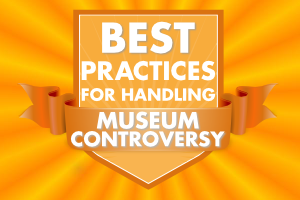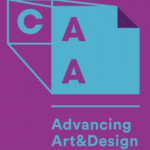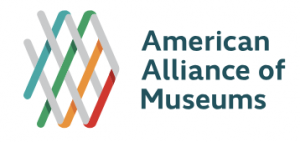Click here for PDF version of this resource
See a history of this resource and its contributors
Preamble
The Museum Best Practices for Managing Controversy is designed to provide museums and other cultural institutions of any size or scope with guidelines that can help manage controversial content and transform controversy into a learning moment about the nature of diverse opinions and an institution’s ability to address them. This non-binding document of best practices offers guidance to an institution concerned about or confronted with accusations of inappropriate, objectionable, or offensive content. Institutions caught in the frantic environment of controversy can refer to this set of strategies designed to calm the waters, open space for conversation and learning, and prevent or defuse a potentially volatile situation through deliberate steps to create meaningful dialogue.
When these guidelines are regularly used by cultural institutions and referenced as a recommended resource by their respective professional associations, the body of practice across the field becomes stronger and more consistent, building credibility and a positive image of all organizations. The simple ingredient of a nationally recognized protocol creating time and space to open dialogue may prevent an over-cautious, self-punishing reaction by institutions caught up in controversy. It may also encourage the institution to address sensitive issues of civic engagement and help fulfil the museum’s mission as a forum for the exploration of diverse ideas.
Introduction
The guidelines reflect an in-depth analysis of various historical and current sources, among them governance documents produced by arts and culture organizations as well as academic institutions, and statements by individual representatives of exhibiting institutions. The guidelines consist of two components: a free-speech statement that may be adopted in its entirety and a best practices template that may support exhibiting institutions, museums, performance spaces, art schools and others when they draft their own procedures, specific to their particular needs.
There are three strategies museums can use to resist pressure and assure their curatorial autonomy:
1. Public Statement Affirming Commitment to Artistic and Intellectual Freedom of Speech (“Freedom of Speech Commitment”);
2. Preparation in Advance of Upcoming Programs and Potential Controversy, through agreement on clear curatorial procedures, feedback mechanisms, and educational plans;
3. Procedures for Addressing the Press or Complaints from the Public after an Exhibition or Special Program Opens.
Taken together, the Free Speech Commitment and the procedures to anticipate and respond to controversy will help to:
• Equip an institution with the tools to respond to criticism of controversial content;
• Improve relationships with the public;
• Support the right of audience members to access a wide variety of work;
• Safeguard the exhibiting institution against self-censorship;
• Introduce transparency;
• Ensure institutional support of curatorial decision-making; and
• Provide board member orientation.
The promotion and use of these strategies by national organizations and leading institutions will help validate them as the best practices in the field, and will help create communities of support when controversy arises in a specific institution.
Freedom of Speech Commitment
Each institution is encouraged to draft a Freedom of Speech Commitment statement.
Sample / suggested template:
Freedom of speech is the foundation of our communities and our nation. The works this institution exhibits may awe, illuminate, challenge, unsettle, confound, provoke, and, at times, offend. We defend the freedom to create content and exhibit such work anywhere in the world, and we recognize the privilege of living in a country where creating, exhibiting, and experiencing such work is a constitutional right.
To exhibit a work of art is not to endorse the work or the vision, ideas, and opinions of the artist. It is to uphold the right of all to experience diverse visions and views. If and when controversies arise from the exhibition of a work of art, we welcome public discussion and debate with the belief that such discussion is integral to the experience of the art. Consistent with our fundamental commitment to freedom of speech, however, we will not censor exhibitions in response to political or ideological pressure.
Preparation in Advance of Upcoming Programs and Potential Controversy
a. Specify clear curatorial selection procedures. Such procedures help institutions respond to complaints.
- Document internal curatorial selection criteria.
- Specify who is responsible for selection (gallery director, curatorial department, faculty members, peer panel); specify composition of the panel (e.g., artists, curators, and other arts professionals or arts patrons); and explain how its members are selected.
- In the case of open calls and juried exhibitions, specify procedures and deadlines from the initial stage (application forms or submission of proposals) to the final decision.
b. Create an educational/public engagement schedule and framework for the exhibition before it opens.
- Collect materials that identify the artist, the exhibition, and the larger context and history of the work.
- After the curatorial process is completed, provide opportunities for community dialogue to help prepare educational programming around an exhibition. The purpose of such discussions is not to limit curatorial decision-making but to help with outreach and engagement of the community.
Qualitative research from focus groups can help museums to strategize on how they might acknowledge particular sensitivities and engender trust through interpretation, programming, partnerships, and communications.
- Identify target audiences: It is important to identify audiences who can provide genuine input and not needlessly empower oppositional groups, who are often not interested in dialogue but rather in stirring controversy to promote their specific agendas.
- Workshops: In order to promote respectful discussion, an institution should encourage dialogue, prepare for effective responses to criticism, and provide guidance on issues of presentation such as phrasing of text, staff training, and responding to public queries.
c. Carry out preliminary public relations.
- Create a strong communications plan before there is a problem, especially in cases where there is concern about possible controversy.
- When appropriate, launch a media campaign to present your position and offer opportunities for dialogue.
- When concerned about a potentially difficult project, find supporters among your funders and form coalitions with other arts organizations or community groups. This strategy builds trust, understanding, and more fruitful alliances.
d. Make use of signage/educational programming.
- Written warnings or disclaimers should be informational and not prejudicial.
- Produce a variety of educational materials.
e. Plan communications between the curator, the educators, and the board.
- The curator and the museum director work with the board to inform them about upcoming shows and prepare them to answer questions about an exhibition.
- Plan conversations and collaborations between curators and educators, from the earliest stages of what might be deemed potentially difficult projects, to develop opportunities for constructive civic engagement.
f. Review the institution’s crisis plan and consult with your legal counsel.
Procedures for Addressing the Press or Complaints from the Public after an Exhibition or Special Program Opens
A statement of support for freedom of speech works best if accompanied by a policy outlining the appropriate response in a situation where an individual or a group complains about the content of work on display. The policy statement should include procedures to help avoid disputes about content and interpretation.
The two core elements in response to a complaint are:
- Leave the exhibition exactly as it is while establishing a period for review and discussion.
- Establish a learning opportunity by creating possibilities for thoughtful discussion between concerned stakeholders.
Handling Complaints from the Community
- Ensure the work stays on display until the controversy has been reviewed.
- Alert the director/those in executive positions, including the PR department and general counsel, of the complaints and any context surrounding them. Complaints should be brought to the attention of the director or staff member responsible for managing such issues.
- Notify the artist(s) and funders and prepare them for possible press attention. In some cases it may be better to recommend that the concerned artists do not take press calls.
- Evaluate the complaint(s): Who is complaining? What are their credentials? Is the complaint sincere criticism or an act of political opportunism by a group leveraging controversy to serve other goals?
- If you do not have one, create a crisis plan. Appoint a “crisis manager” along with an ad hoc team that is best equipped to deal with the situation.
- Prepare and disseminate talking points/questions and answers.
- Find supporters. Form coalitions with other arts organizations and activate networks. Contact existing arts and free speech groups.
- Provide a copy of the exhibition selection procedure or similar document to the complainant.
- Develop an official complaint form. If the complainant is not satisfied after discussing the details of the exhibition and artist’s intent, have the complainant formally lodge his/her complaint in writing.
- Schedule additional programming to provide a platform for diverse opinions.
- Consider contacting legislators or other public officials, if appropriate.
Working with the Press and Media
- Establish one spokesperson to discuss the institution’s programming priorities with the public and the media. Ensure that all board members defer to the spokesperson and otherwise refrain from all comments in all public places or circumstances.
- Focus on the museum’s mission, rather than the details. Contextualize an exhibition within the museum’s exhibition history. Avoid an approach that empowers the opposition and allows him/her to frame the discussion.
- Use the dynamics of the media to your advantage and be aware of the difference between the cultural press and hard news, as well as who is writing/producing the story, what section of a paper/type of broadcast it will appear in, and who is editing it.
- Involve the board and key staff in refining the communication plan (developed in the preparatory stage).
- Use a straightforward, neutral approach.
- Consider seeking the assistance of a PR or crisis management firm.









